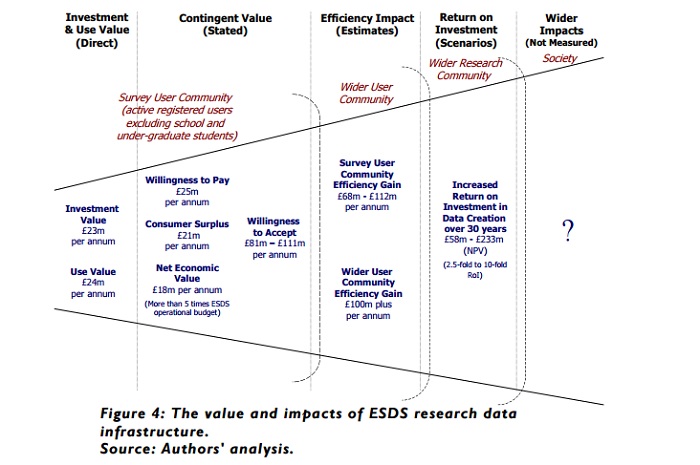UK Data Service director Matthew Woollard discusses how the provision of a single infrastructure for data resources can result in efficiency savings for research institutions and data owners alike.
As identified in the Diamond report on Efficiency, effectiveness and value for money, there are efficiency savings to be made within higher education by having a shared infrastructure.
I was really pleased to read in his report that Professor Sir Ian Diamond referred to us at the UK Data Service, as a “leading example of data sharing”. Our service, which is funded by the Economic and Social Research Council, provides users with access to a wide range of data resources and focuses in particular on enabling high quality social and economic research and education.
We hold the nation’s largest collection of digital research data in the social sciences and we make more than 6,500 data collections freely available at the point of use to a diverse range of users. These data collections span major UK government-sponsored surveys, cross-national surveys, longitudinal studies, UK census data, international aggregate data banks, business microdata and qualitative and mixed methods data.
Each year we help more than 25,000 registered users – plus numerous users who choose not to register – gain access to a wealth of data. We also provide supporting resources that include dedicated user guides, pedagogical materials and a rich training programme in a range of formats.
Quantifying the ‘value’ of sharing research data
As Professor Diamond points out, there are “significant efficiencies to be gained through the open sharing of research data”. Again, the arguments are straightforward; expensive data collection exercises are not duplicated and, potentially, returns on initial investment are increased.
The economic arguments are augmented by benefits to the researchers. Not only are the inputs into research free, data sharing increases the visibility of their research, and may increase citation and promote collaboration, for the creators of data, data sharing can increase their visibility and reputation as the owner of a significant resource.
In the Economic Impact Evaluation of the Economic and Social Data Service (the ESDS was integrated into the UK Data Service), carried out in 2012, Neil Beagrie and John Houghton used both qualitative and quantitative approaches to ascertain the broader contribution of the ESRC’s investment to the economy.
In terms of research efficiency, Beagrie and Houghton estimated that researchers, based on responses to a survey of users, saved around 25% of their research time by being able to use the service. Extrapolating this upwards they estimated a national efficiency saving of around £41m each year, and this excludes efficiencies made in teaching and beyond the higher education sector.
Everyone’s a winner
When examining the wider economic impacts and benefits of this data infrastructure, this study estimated direct efficiency impacts for our active registered user community (excluding school and undergraduate students) of £68m to £112m per annum—which could amount to at least £100m per annum or more for the wider user community.
The same report calculated a consumer surplus of £21m per annum among the survey user community and an implied a net economic value of around £18m per annum — more than five times the existing ESDS operational budget – so every £1 spent on ESDS realised £5.40 value.
However, given that the analysis did not include a survey of non-users, the authors were unable to formally estimate the total economic value. The ESRC report on the ESDS used an appealing illustration to demonstrate the value of research and teaching efficiency gains realised by ESDS users and indicating the impacts of ESDS on the user community.

What’s in this for data owners?
As I’ve said, benefits aren’t just going to the (re) users of data collections; data owners have a lot to gain from a shared data infrastructure. The data owners we deal with vary from large-scale data producing operations to academics with small research grants.
We work with major international organisations such the World Bank, IMF and OECD, which already have their own access infrastructure but which license data via the UK Data Service to UK users, and with UK statistical agencies and government departments, where possible, using a specially-developed concordat. We also work proactively with individual researchers and research centres, to operate the ESRC’s own research data policy that strives to make all research data supported by the ESRC available for future use, offering a simple self-deposit system together with plenty of encouragement.
All data owners benefit from the data curation service which the Data Service provides. The Data Service provides long-term curation services, which means that the data owner does not need to manage their data in the long term; we provide that for them.
We also ensure that data is properly prepared for access in a consistent and robust manner, according to international best practice. This in turn promotes research integrity. We guarantee that what one user accesses is exactly the same as what another researcher accesses in five years’ time, and can always be found – or we tell them what’s changed! You can’t say that for much of the data you can find on the web, where ‘persistence’ is unpredictable.
We provide many added value services to data owners: letting them know the extent to which their data is being reused and even in some cases where it is having an impact, proactively promoting data to wide audiences through our communications networks, running tailored workshops to introduce their data, creating teaching and taster datasets from more complex data they provide, publishing their data in our online visualisation tools; and co-authoring case studies of re-use with new users. Thus the benefits to data owners extend well beyond time and resource savings.
Driving impact
And the benefits extend beyond this. The ESRC report on the ESDS itself noted that the benefits of the data service infrastructure like ours would extend beyond even their frame of reference, stating “there are many wider economic and social impacts arising from the use of ESDS data (e. g., in influencing policy decisions and driving social outcomes) that are not being captured in this analysis.” We publish a range of these “impact case studies” on our website.
Data in the UK Data Service collection have huge potential. They can unlock new discoveries in research, provide evidence for policy decisions and help teach the next generation in core data skills. By being part of a single infrastructure, data owners/creators can work together with the UK Data Service – rather than duplicating efforts – to engage with the persons who can drive the impact of their research further to provide real benefit to society.
You can read a blogpost, co-authored by myself and my colleague James Nazroo on how the UK Data Service creates, curates, enriches and reuses data already collected by government departments and researchers.
Our Data Impact Blog also provides some nice case studies around the impact that our Service has. You can follow it to see our latest developments in this area, and join in the debate – this platform serves as a hub for academics, communities, policy-makers, government and anyone interested in maximising the impact of social, population and economic data in research and policy.
Matthew Woollard is the director of the UK Data Service








